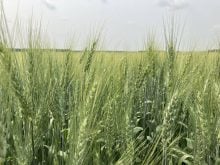Farmers looking for drought tolerant canola will have access to two new juncea canola varieties this spring.
Xceed 8571 and Xceed 8470 are available for production under an identity preserved contract through Viterra.
Both varieties offer resistance to blackleg and fusarium wilt, and have good lodging resistance and medium maturity. Both are Clearfield varieties.
According to Viterra, juncea canola’s greatest assets are its upright stand and increased tolerance to drought and shattering.
Because of these traits, Xceed canola can be grown in non-traditional growing regions and is suited to straight-cut combining.
Read Also

Why feds imposed EV tariffs
Moe and Kinew have a fight on their hands when it comes to eliminating the EV tariff. Canada has to worry about pissing off the U.S. and Mexico and hundreds of thousands of auto workers.
Viterra says research has shown that producers who straight combine Xceed canola at the proper stage can achieve higher yields than those who swath it.
Shattering losses for Xceed varieties are less than Argentine canola and similar to brown and Oriental mustard, the company says.
When sowing Xceed, farmers should select a field that hasn’t been planted to mustard for at least three years to avoid contamination by volunteers.
A seeding rate of six to seven pounds per acre is recommended to produce a plant stand of 17 plants per sq. foot.
If the crop is swathed, the optimal stage is at 60 to 75 percent seed colour change. However, Viterra says Xceed can be swathed as early as 30 to 40 percent seed colour change without significantly affecting yield and quality.
Viterra officials say juncea canola’s drought tolerance could expand canola production on the Prairies.
So far, however, acreage is small and growers’ reviews have been mixed.
Tim Wiens, a farmer near Herschel, Sask., who serves on the board of directors of the Saskatchewan Canola Development Commission, grew Xceed in 2009. He was not happy.
“I don’t know if it was because of environmental reasons, but my Xceed crop was horrible,” he said.
“It never came out of the ground, and what did come couldn’t compete with the other canola. Maybe it was because of the delayed early rains. You need to have a plant growing before you can assess its drought tolerance.”
Wiens said straight combining was not an option because of variable staging.
“I had canola in 10 different stages of maturity, so I swathed it all. I didn’t dare leave the Xceed to be straight cut or it would still be standing.”
Xceed was developed by breeding standard canola with mustard to produce a plant with canola-quality oil.
Development of the crop began in the early 1990s when researchers saw the need for a canola variety that could be grown in drier, non-traditional canola growing areas.
Researchers recognized that Brassica juncea had many desirable traits including increased tolerance to frost, heat and drought, lower green seed counts, and increased pod shatter resistance.
Xceed can be grown in brown and dark brown soil zones where growers in the past have had only moderate success growing canola.














